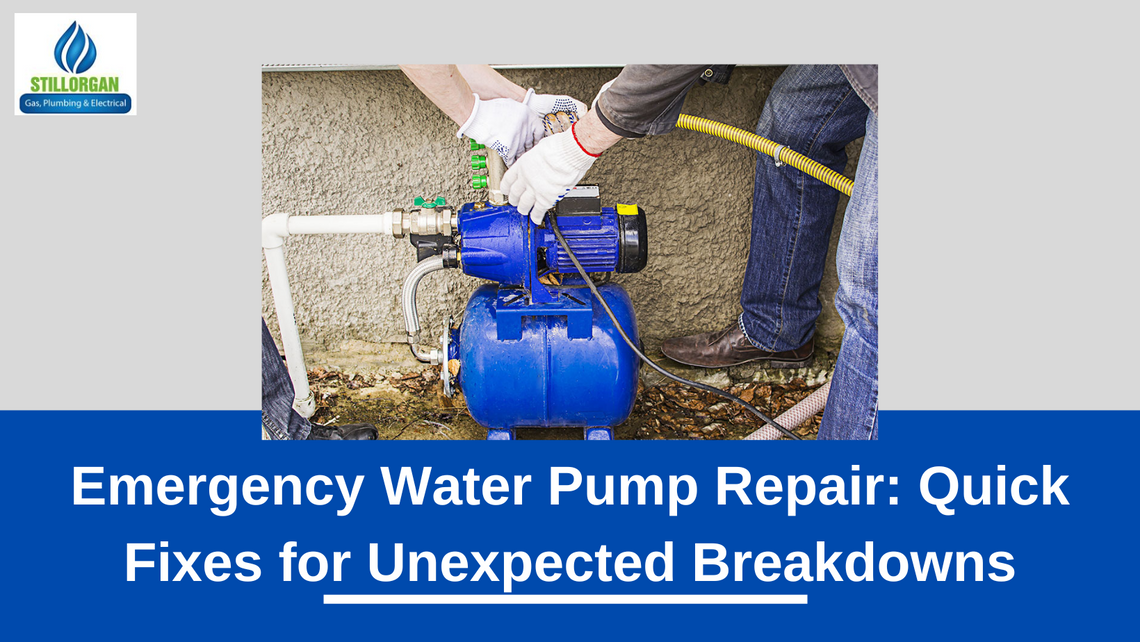
31/05/2023 by stillorgangas 0 Comments
Emergency Water Pump Repair: Quick Fixes for Unexpected Breakdowns
"Discover essential tips and quick fixes for unexpected water pump breakdowns in our latest blog. Learn how to assess the situation, prioritize safety, troubleshoot common issues, implement temporary solutions, and know when to seek professional help. Don't let a water pump failure disrupt your water supply - be prepared and equipped with the knowledge to handle emergencies effectively."
A water pump is important to providing a reliable and regular water supply. It is used in many different kinds of systems, including domestic plumbing, irrigation for farming, industrial processes, and municipal water delivery. A water pump's principal job is to transport water from one area to another while overcoming gravity, friction, and other causes that obstruct water flow. Understanding the significance of a water pump allows us to comprehend its function in ensuring access to safe drinking water.
Assessing the Situation:
Recognizing the signs of a water pump failure:
It is critical to recognize the frequent indicators of a water pump failure. Low water pressure, inconsistent water flow, odd noises originating from the pump, frequent pump cycling, or complete cessation of water flow are all symptoms. By recognizing these indicators, you may determine if your water pump is malfunctioning and take proper action.
Safety precautions: Turning off power supply and water sources:
Prioritizing safety is crucial while dealing with a broken water pump. To avoid any potential electrical risks, start by cutting off the water pump's power source. The pump's power source can be disconnected or the circuit breaker turned off to accomplish this. Additionally, cutting off the water supply to the pump can assist stop any additional flooding or water damage.
Determining the type of water pump and its components:
Water pumps vary in type and arrangement based on the system in which they are installed. It is critical to understand the type of water pump you have, such as a submersible pump, centrifugal pump, or jet pump. This knowledge will assist you in better understanding the components and mechanisms involved in your individual pump system. Familiarize yourself with the major components of your water pump, such as impellers, seals, motors, electrical connections, and pressure switches.
Troubleshooting Steps:
A. Power Supply and Electrical Connections:
Checking circuit breakers and fuses:
Examine the circuit breakers in the electrical panel or fuse box to ensure they have not tripped or blown. If a breaker has tripped, switch it off and then back on to reset it. If a fuse has blown, replace it with a new one of the same rating.
Resetting tripped breakers or replacing blown fuses:
Resetting a tripped breaker involves flipping it to the "off" position and then back to the "on" position. For blown fuses, you need to replace them with new ones to restore the electrical connection.
Inspecting electrical connections and addressing loose or damaged wires:
Carefully inspect the electrical connections leading to the water pump. Look for loose or disconnected wires, frayed insulation, or signs of damage. Tighten any loose connections and repair or replace damaged wires as necessary. It's essential to ensure secure and proper electrical connections for the water pump to function effectively.
B. Dealing with Air Locks:
Identifying airlock symptoms:
Airlocks can occur when air becomes trapped in the water pump or plumbing system, causing a disruption in water flow. Symptoms of airlocks include sputtering faucets, inconsistent water pressure, or no water coming out of the taps.
Releasing air from the system through bleeding valves or priming techniques:
To release air from the system, locate any bleeding valves in the water pump or associated plumbing components. Open these valves slightly to allow air to escape until only water flows. Alternatively, you can prime the pump by adding water directly into the pump housing or using priming techniques specified by the manufacturer.
C. Clearing Clogs and Debris:
Detecting and addressing clogs or debris obstructing the pump's intake or impellers:
Inspect the water pump's intake area, such as the strainer or intake valve, for any visible clogs or debris. Remove any obstructions carefully, ensuring not to damage the pump or its components. Additionally, check the impellers for any debris that may hinder their movement.
Using a plunger, pipe snake, or cleaning chemicals to clear blockages temporarily:
If the clog is further down in the plumbing system, you can use a plunger or pipe snake to attempt to clear it. For stubborn clogs, you may consider using cleaning chemicals specifically designed for clearing pipe blockages. Follow the manufacturer's instructions and exercise caution when using such chemicals.
D. Addressing Leaks:
Identifying the source of leaks:
Look for any signs of leaks in the water pump, pipes, fittings, and connections. Look for puddles of water, wetness, or dripping water. identify the source of the leak to identify the best line of action.
Applying temporary solutions such as tightening fittings, using sealants, or applying plumber's tape:
If the leak is caused by loose fittings, tighten them securely. For small leaks, you can apply plumber's tape or sealants designed for temporary repairs to provide a temporary seal. However, keep in mind that these solutions are temporary, and professional repairs may still be required.
E. Assessing and Addressing Mechanical Issues:
Examine for worn-out impellers, damaged seals, or broken belts:
Inspect the pump's impellers, seals, and belts for evidence of wear, corrosion, or misalignment. Worn-out impellers may need to be replaced, while damaged seals may require professional repair or replacement. Broken belts should be replaced with new ones that match the pump's requirements.
Providing temporary repairs or replacements where feasible:
If you have the necessary skills and knowledge, you can attempt temporary repairs for mechanical issues such as replacing impellers or seals. However, it's important to remember that permanent repairs or replacements should be performed by a qualified
Temporary Fixes:
A. Utilizing Backup Water Sources:
Having alternative water sources available, such as bottled water or stored water containers:
During a water pump breakdown, it is essential to have backup water sources readily available. This can include bottled water, water stored in jugs or containers, or water obtained from alternative sources like nearby wells or streams. These alternative water sources can help meet basic needs such as drinking, cooking, and basic hygiene until the water pump is repaired.
Implementing water rationing techniques during the temporary period:
To conserve the available water, it is important to implement water rationing techniques. This involves using water judiciously and only for essential purposes. Some tips for water rationing include taking shorter showers, reusing water for multiple tasks (such as using dishwater to water plants), and fixing any leaks or dripping faucets promptly.
B. Renting or Borrowing Portable Water Pumps:
Seeking rental options for portable water pumps:
If the water pump repair is expected to take some time, renting a portable water pump can be a viable solution. Contact local hardware stores, equipment rental companies, or water pump suppliers to inquire about rental options. They can provide you with a portable water pump that can temporarily restore water flow until the main pump is repaired.
Tips for selecting and operating portable pumps safely:
When renting or borrowing a portable water pump, consider the following tips:
- Choose a pump that is suitable for your specific needs, taking into account the required flow rate and pressure.
- Ensure that the rented pump is in good working condition and free from any damage or leaks.
- Read and follow the manufacturer's instructions for safe operation, including proper setup, priming, and maintenance.
- Use the appropriate power source and ensure that all electrical connections are secure and grounded.
- Monitor the pump regularly and address any issues promptly to prevent further damage or accidents.
When to Seek Professional Help:
Recognizing situations that require professional intervention:
While temporary fixes can help restore water flow temporarily, there are situations where professional help is necessary. Some signs that indicate the need for professional intervention include:
- Severe pump damage or mechanical failure that cannot be addressed with temporary repairs.
- Electrical issues that require the expertise of an electrician.
- Complex plumbing problems or leaks that cannot be resolved with temporary solutions.
- Continued pump malfunction or recurring issues despite temporary fixes.
Understanding the limits of temporary fixes and the importance of expert repairs:
Temporary fixes are meant to provide immediate relief and restore water supply temporarily. However, they are not permanent solutions and should not replace professional repairs. It is important to recognize the limitations of temporary fixes and understand that expert repairs are necessary to address the root cause of the problem and ensure long-term reliability and functionality of the water pump system. Seeking professional help will help prevent further damage, ensure proper repairs, and minimize the risk of future breakdowns.
Conclusion
Addressing water pump breakdowns promptly during emergencies is crucial to minimize inconvenience and prevent further damage. By following the troubleshooting steps and temporary fixes outlined in this article, individuals can temporarily restore their water supply until professional repairs can be arranged. Remember to prioritize safety, and when in doubt, always seek professional assistance. Regular maintenance and inspections can also help prevent unexpected breakdowns and ensure the long-term reliability of your water pump system. By being prepared and knowledgeable, you can effectively navigate water pump emergencies and safeguard your water supply.

Comments
Leave a comment